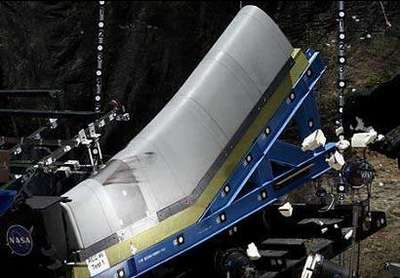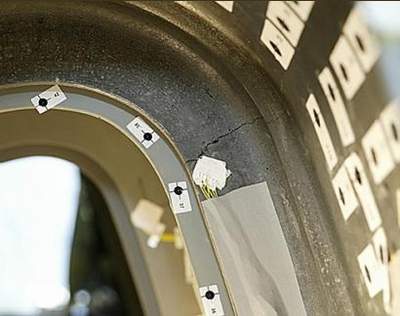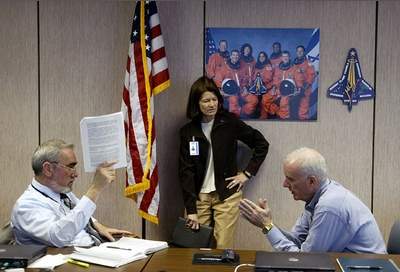Simulation Indicates Fuel Tank Debris Could Have Caused
Disaster
It's the kind of gun used to fire all sorts of debris at
aircraft parts, testing the results of impact. This time, the
35-foot long gun fired a piece of insulating foam at a wing panel
from the space shuttle Discovery, causing the panel to
bend and crack. Investigators trying to figure out what caused the
shuttle Columbia to break up as it re-entered the Earth's
atmosphere Feb. 1 say this is a big - perhaps crucial step - in
finding out what killed the seven astronauts on board.

Using parts from Discovery, scientists at the Southwest
Research Institute Saturday proved that, at least in theory,
insulation foam from the shuttle's main fuel tank could have indeed
caused catastrophic damage to the wing of shuttle
Columbia.
Smoking Gun?
That unique test gun at the institute in San Antonio fired a 1.5
pound chunk of foam into panels from the leading edge of
Discovery's wing. As members of the Columbia Accident
Investigation Board looked on, the foam insulation cracked the wing
panel and created a tiny gap between the panel and an adjoining
seal.
The result of the three-inch crack? Super-heated gas could have
seeped into the wing, causing a meltdown of vital structural
components, leading to the destruction of Columbia on Feb.
1.
"We demonstrated for the first time that foam at the speed of
the accident can actually break" shuttle wing components made from
reinforced carbon, said Scott Hubbard, the head of NASA's Ames
Research Center and a member of the Columbia Accident Investigation
Board (CAIB). "To me, that's a step forward - maybe even a
significant step forward - in our knowledge. We need to complete
the test series to understand the whole story.

The foam sample in the lab hit the Discovery wing panel
at 525 mph, the speed at which a suitcase-sized chunk of foam from
Columbia's fuel tank hit the orbiter's left wing Jan. 16.
Columbia disintegrated as it re-entered Earth's atmosphere
Feb. 1, raining down debris from central Texas to western
Louisiana.
Almost 100 people, two of them shuttle astronauts, along with 12
high-speed cameras, watched as the foam shattered along the 22-inch
long wing panel. The crack was visible to the naked eye.
"If such a crack had been found on an inspection," said Hubbard,
"you would not fly with it. You would not take a piece that is this
damaged into space."

End Of The Investigation
With Saturday's test, the CAIB's active investigation ended.
Now, the 13 board members will write their final report, due to the
President, Congress and the American public by the end of next
month. Already, an early draft of that report obtained by The
Orlando Sentinel indicates NASA's problems extend far beyond
the foam that insulates the external fuel tank. The Sentinel
reports the draft portrays the Columbia tragedy as just the tip of
the iceberg - a mountain of problems that the newspaper says
included communication breakdowns and ignored or downplayed warning
signs. The CAIB report indicates it was nothing sudden, but rather
a gradual erosion of diligence that contributed to the Columbia
disaster. The report also blames the White House and Congress for
not, in board members' opinions, properly funding the shuttle
program.

But closer to the actual disaster, a chapter in the CAIB report
called "Columbia's Final Flight" contains a series of
e-mail messages analyzing the Jan. 16 foam strike. The messages are
sometimes angst-ridden as engineers ponder the measure of damage to
the shuttle's wing and the risk it posed to the crew of seven.
 Aero-FAQ: Dave Juwel's Aviation Marketing Stories -- ITBOA BNITBOB
Aero-FAQ: Dave Juwel's Aviation Marketing Stories -- ITBOA BNITBOB NTSB Prelim: Rutan Long-EZ
NTSB Prelim: Rutan Long-EZ ANN's Daily Aero-Term (12.05.25): Hazardous Weather Information
ANN's Daily Aero-Term (12.05.25): Hazardous Weather Information Aero-News: Quote of the Day (12.05.25)
Aero-News: Quote of the Day (12.05.25) Airborne-Flight Training 12.04.25: Ldg Fee Danger, Av Mental Health, PC-7 MKX
Airborne-Flight Training 12.04.25: Ldg Fee Danger, Av Mental Health, PC-7 MKX






